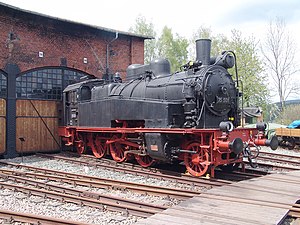This article includes a list of general references, but it lacks sufficient corresponding inline citations .(September 2016) |
| Saxon Class XIV HT DRG/DR Class 75.5 | |||
|---|---|---|---|
 | |||
| Manufacturer: | Sächsische Maschinenfabrik, Chemnitz | ||
| Numbering: | 1801–1850 75 511–550 | 1851–1855 75 501–505 | 1856–1906 75 551–588 |
| Built: | 1911–1915 | 1915 | 1917/18, 1921 |
| Retired: | by 1970 | ||
| Quantity: | 50 | 5 | 51 |
| Wheel arrangement: | 2-6-2T | ||
| Axle arrangement: | 1′C1′ h2t | ||
| Track gauge: | 1,435 mm (4 ft 8+1⁄2 in) | ||
| Length over buffers: | 12,415 mm (40 ft 8+3⁄4 in) | ||
| Fixed wheelbase: | 2,800 mm (9 ft 2+1⁄4 in) | ||
| Overall wheelbase: | 8,700 mm (28 ft 6+1⁄2 in) | ||
| Empty weight: | 60.1 t | 62.7 t | 64.2 t |
| Service weight: | 76.7 t | 79.4 t | 82.2 t |
| Adhesive weight: | 47.7 t | 48.8 t | 49.5 t |
| Axle load: | 15.9 t | 16.3 t | 16.5 t |
| Top speed: | 75 km/h (47 mph) | ||
| Indicated Power: | 990 PS (730 kW; 980 hp) | ||
| Driving wheel diameter: | 1,590 mm (5 ft 2+5⁄8 in) | ||
| Carrying wheel diameter: | 1,065 mm (3 ft 5+7⁄8 in) | ||
| Valve gear: | Walschaerts (Heusinger) | ||
| No. of cylinders: | 2 | ||
| Cylinder bore: | 550 mm (21+5⁄8 in) | ||
| Piston stroke: | 600 mm (23+5⁄8 in) | ||
| Boiler overpressure: | 12 kg/cm2 (1,180 kPa; 171 psi) | ||
| No. of heating tubes: | 132 | ||
| Heating tube length: | 4,000 mm (13 ft 1+1⁄2 in) | ||
| Grate area: | 2.30 m2 (24.8 sq ft) | ||
| Radiative heating area: | 11.8 m2 (127 sq ft) | ||
| Tube heating area: | 110.5 m2 (1,189 sq ft) | 119.8 m2 (1,290 sq ft) | 110.5 m2 (1,189 sq ft) |
| Superheater area: | 36.2 m2 (390 sq ft) | 65.0 m2 (700 sq ft) | 36.2 m2 (390 sq ft) |
| Evaporative heating area: | 122.3 m2 (1,316 sq ft) | 131.58 m2 (1,416.3 sq ft) | 122.3 m2 (1,316 sq ft) |
| Water capacity: | 8.0 m3 (1,800 imp gal) | 8.0 m3 (1,800 imp gal) | 9.0 m3 (2,000 imp gal) |
| Coal capacity: | 2.5 t | 2.5 t | 2.8 t |
| Brakes: | Westinghouse compressed-air brake | ||
The Saxon Class XIV T locomotives were six-coupled tank engines operated by the Royal Saxon State Railways for mixed duties on main and branch lines. In 1925, the Deutsche Reichsbahn grouped them into their DRG Class 75.5.
